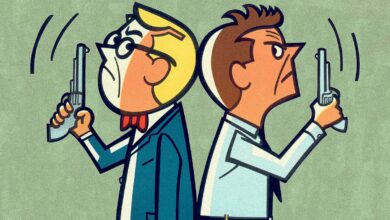I Love You, You Hate Me: Why did so many people want to murder Barney the Dinosaur?

In November 1997, Barney the Dinosaur was stabbed to death by the New York City Police Department. If you’re thinking this is the start of a dark and gritty fanfiction, I can assure you there is ample video evidence of the slaughter online – under headlines such as “Barney Died a Violent Death”, “Watch Barney Get Destroyed”, or “Watch Balloon Barney Die in the Cruel Thanksgiving Parade”. Alright, so that last one gives away that it wasn’t the original Barney that was slain. Rather, this was a vast inflatable version of the all-singing, all-dancing dinosaur beloved by hyperactive Nineties preschoolers, and the star of the show at that year’s Macy’s Thanksgiving Day Parade. Until, that is, wild winds threw Barney towards the onlooking crowds. In an instant the character became less “I love you, you love me” Barney, more a lurid Godzilla threatening to crush and suffocate hordes of young children. Then a different kind of disaster struck. A powerful gust shoved Barney into a lamppost, ripping him open. As he flailed – his wound flapping horribly – the NYPD moved in with knives to bring the 58-foot dino down. Swarming on Barney’s back like ants, the police did what they do best. They murdered him in public.
What I didn’t realise when I first saw the footage a couple of years ago was that, when it came to human on purple T rex violence, balloon-Barney’s untimely demise was far from an isolated incident. From the mid-Nineties onwards, the big, friendly dinosaur found himself at the centre of a hate campaign, increasingly subject to vicious public assaults. All over America, and indeed in many of the 252 countries where Barney & Friends was shown on television, plush toys of the icon were filmed being burnt, blown up, run over, or shot. Why were so many people keen to watch Barney get destroyed? What had Barney done to deserve such hate?
A new docuseries, impeccably titled I Love You, You Hate Me, gets under Barney’s foam suit to chart the TV show’s spectacular rise and equally spectacular backlash against its central character. Opening with a montage of fiery “Barney bashing” videos – put to the now familiar strains of “shock doc” intro music – the two-parter attempts to get to the bottom of why such a cuddly character inspired such ire. Along the way, it careers into wackiness, like a Looney Tunes star hurtling off a cliff and landing on a pile of rakes. For example, did you know the man who was the physical incarnation of Barney for a decade – the guy inside the suit – is a tantric energy healer and sex therapist? David Joyner, who played Barney from the show’s inception in 1992 to 2001, had to sign a contract promising he would not even talk about tantra while associated with the show. A few of the other Barney & Friends alumni featured still seem concerned that he’s talking now, and perhaps for fair reason – at one stage of the documentary Joyner is pressed about how many of his clients get “the whole package” (ie a personal tantric sex session with their ex-Barney energy healer).
Yet Joyner is far from the most bizarre element of this TV trip. Did you know it’s believed that the Pentagon used Barney music as a torture device, forcing prisoners to listen to his saccharine and relentlessly peppy theme song for 24 hours straight? Did you know that the son of Sheryl Leach, one of the show’s creators, once shot his neighbour multiple times in the chest? Or that one of the very first websites in existence was named “alt.dinosaur.Barney.die.die.die”? Or that there was once a roleplaying game called “The Jihad to Destroy Barney”, supposedly dedicated to the “general eradication of Barney the Dinosaur from television airwaves, the internet, all media, and the face of the Earth”?
At one stage of the docuseries, a few of the talking heads link popular “Barney bashing” events on college campuses to a distinctly Nineties kind of nihilism – the same streak of macho, Fight Club-ish existential ennui and aggression that sparked up at Woodstock ’99. I Love You, You Hate Me revolves around, and resolves itself in, a belief that this prevailing mood – “rebels fighting against the conformity of the normies” – was baked into the internet at its nascent beginning. Towards the end, it draws a line between Barney hate groups and the contemporary, conspiracy drenched alt-right; an opening montage of purple toys being shot is later replaced with a montage of the Capitol riots. A commentator asks: “Is this … when the world learned to love to hate?”
Yet, to me at least, what is most interesting about this niche pocket of time and internet culture is not really about hate per se, but about humour. Take the Barney hate groups featured in the docuseries, and specifically a support group for parents with “Barney addicts” in the family. It turned out to be founded by a frustrated father who was himself in recovery for alcohol addiction. The anti-Barney pamphlets he created satirised the language and step programme of Alcoholics Anonymous. Suddenly the desperate toddlers playing Barney on incessant repeat are transformed into tiny junkies. Which is, simply, hilarious – a wry and surreal bit of poking fun that turns difficult subjects such as alcoholism and parenting into things that are lighter, more entertaining, and a lot easier to grapple with. If you don’t laugh, you’ll cry, right?
Ever since the beginning of children’s entertainment, there has been an opposing history that juxtaposed it – infesting colourful, child-friendly environments with disturbing, adult themes. This is the impulse that created South Park and Beavis and Butt-Head, as well as Family Guy and BoJack Horseman. In August, the internet collectively lost its mind when a trailer appeared for Blood and Honey, an upcoming movie about Winnie the Pooh being left to his own devices in The Hundred Acre Wood, going feral and becoming a bloodthirsty killer. Weeks later, Channel 4 was graced by an anarcho-puppet show that, for the last decade, had been a YouTube sensation. First created in 2011 by Becky Sloan and Joseph Pelling, Don’t Hug Me I’m Scared took the happy learning style of children’s television and twisted it into a work of creepy, hallucinatory horror. Essentially, Don’t Hug Me I’m Scared looks like Sesame Street but feels like a David Lynch movie. And what Lynch is master of, of course, is the uncanny – that sense that underneath a pristine surface lurks something eerie or taboo. The uncanny valley is precisely where children’s entertainment and grown-up horror collides. Kids’ shows about talking toys, living dolls, and clownish animals just about keep their hallucinatory edge in check. Push them a bit further, though, and you enter the realm of terror. Just think of a notorious episode of The Twilight Zone where “Talky Tina”, a girl doll with bow-tied pigtails, murders its owner’s stepfather. Or, indeed, Chucky, the creepiest Hollywood doll of all.
There is a fine line between dreams and nightmares. Often, this line is also where dark, surreal comedy resides – at that hallucinatory point where the unexpected and bizarre occurs. Its effect is a strange thrill. In some ways, this could be seen as the very essence of internet humour: the “everything is fair game” cut-and-paste approach to media content that births memes. It means it’s easy to find edits of Peppa Pig drinking bleach in the internet’s nooks and crannies. Or ringing up Walter White. Or wearing bondage gear.
Even those involved in the making of Barney & Friends – the brigade of Barney aficionado’s attempting to rescue the dino’s reputation from frat-bros and internet haters – seem to instinctively understand the illicit thrill of taking something sugary sweet and adding a hit of subversion. After playing the iconic theme tune at the start of I Love You, You Hate Me, the music director for the first three seasons of Barney & Friends – Grammy-nominated composer Bob Singleton – is asked how it feels “playing that song” 30 years on. “On this piano,” he says, “it’s like death.” Another talking head explains the backlash phenomenon quite succinctly: “Barney is so impossibly wholesome. There is the desire to pop the balloon.”
As Joyner’s no-tantra contract suggests, “Barney’s world” is a chaste world – a prelapsarian paradise of childlike wonder and innocence. Yet as kids hit puberty, they find themselves falling out of “Barney’s world”, and into the real world. Sex. Violence. The state-sanctioned use of children’s music as a weapon. Growing up means realising the world is not all beauty, friendship, love and resolution. Thankfully, upon discovering this, most people don’t turn into rampaging monsters. But, perhaps a lingering sense of betrayal remains? The feeling of having been sold a lie… rather than punching people’s lights out in underground rooms or storming the Capitol, though, some big kids decide to rip a plush toy’s head off and laugh about it with their friends online. In a way, isn’t that kind of sweet?
‘I Love You, You Hate Me’ is streaming now in the US on Peacock, with a UK release yet to be announced





